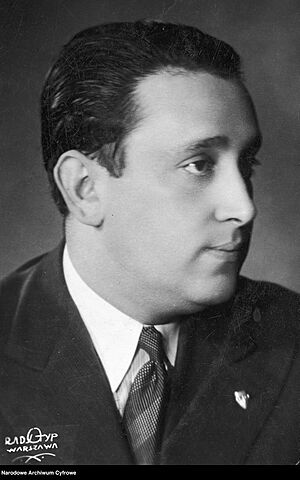Michał Waszyński facts for kids
Quick facts for kids
Michał Waszyński
|
|
|---|---|

Michał Waszyński in 1934.
|
|
| Born |
Mosze Waks
29 September 1904 Kowel
|
| Died | 20 February 1965 (aged 60) |
| Nationality | Polish |
| Occupation | Producer, Film director |
| Years active | 1922–1948 |
Michał Waszyński (born September 29, 1904 – died February 20, 1965) was a talented filmmaker. He started his career as a film director in Poland. Later, he worked in Italy. He then became a successful producer for big American movies, mostly filmed in Spain. People who knew him often called him "the prince" because he was very elegant and had excellent manners.
Contents
Early Life and Career Beginnings
Michał Waszyński was born as Mosze Waks in 1904. His family was Jewish and lived in Kowel, a small town. Kowel was in a region called Volhynia, which is now part of Ukraine. At that time, it was part of Imperial Russia.
During World War I, Germany took control of this area. Young Mosze moved first to Warsaw and then to Berlin. In Berlin, he worked as an assistant director. He learned from a famous German director named F.W. Murnau. When he returned to Poland, he changed his name to Michał Waszyński. He also converted to Catholicism.
Becoming a Prolific Polish Director
In the 1930s, Michał Waszyński became one of the busiest film directors in Poland. He directed 37 out of 147 films made in Poland during that decade. This means he directed one out of every four movies!
He made many popular films in Polish for a wide audience. He also directed a very important film in Yiddish called The Dybbuk. This movie is still seen today as a special reminder of the rich cultural life of Jewish people in Eastern Europe before the Holocaust.
World War II and New Adventures
When World War II began, German planes bombed Warsaw. Waszyński escaped to Białystok. German forces took Białystok in September 1939. However, a few weeks later, the city was given to the Soviet Union due to a special agreement. The Soviet army then occupied it.
Waszyński started a new job as a theater director. He worked first in Białystok and later in Moscow.
In the summer of 1941, Germany invaded the Soviet Union. Waszyński joined the new Polish Army. This army was loyal to the Polish government that was in exile in London. He traveled with the army to Persia (now Iran). Later, as a soldier in the 2nd Corps of the Polish Army, he went to Egypt and Italy.
He was part of the army's film unit. He filmed the Battle of Monte Cassino, a very tough battle where many Polish soldiers were lost. However, their efforts helped win the battle.
Life After the War and Hollywood Success
After World War II, Michał Waszyński stayed in Italy. He directed a Polish-language movie about the Battle of Monte Cassino. Then, he directed three more films in Italian.
Later in his career, Waszyński became a producer for big American film studios. He worked in Italy and mostly in Spain. He was known as Michael Waszynski during this time. Some of the famous movies he helped produce include:
- The Quiet American (1958)
- El Cid (1961)
- The Fall of the Roman Empire (film) (1964)
Michał Waszyński passed away from a heart attack on February 20, 1965, in Madrid. He was buried in a special Roman Catholic funeral in Rome.
Filmography
- William Tell (1949)
- La Grande strada (1948) Polish film produced in Italy, (1946, Italian version completed in 1948, with the collaboration of Vittorio Cottafavi); with Jadwiga Andrzejewska
- Fire Over the Sea (1947)
- The Unknown Man of San Marino (1946)
- Wielka droga (1946)
- Monte Cassino (1944)
- Mp. Adama i Ewy (1944)
- Dzieci (1943)
- Pobyt generala Wl. Sikorskiego na Srodkowym Wschodzie (1943)
- Polska parada (1943)
- Kronika wojenna nr 1 (1942)
- Marsz do wolnosci (1942)
- Od pobudki do capstrzyku (1942)
- The Three Hearts (1939)
- U kresu drogi (1939)
- The Vagabonds (1939)
- Serce matki (1938)
- Gehenna (1938)
- Profesor Wilczur (1938)
- Ostatnia brygada (1938)
- Druga młodość (1938)
- Kobiety nad przepaścią (1938)
- Rena (1938)
- The Dybbuk(1937)
- Znachor (1937)
- Papa się żeni (1936)
- Bohaterowie Sybiru (1936)
- Dodek na froncie (1936)
- 30 karatów szczęścia (1936)
- Będzie lepiej (1936)
- Bolek i Lolek (1936)
- Nie miała baba kłopotu (1935)
- Panienka z poste restante (1935)
- Wacuś (1935)
- Jaśnie pan szofer (1935)
- ABC miłości (1935)
- Antek policmajster (1935)
- Czarna perła (1934)
- Kocha, lubi, szanuje (1934)
- Pieśniarz Warszawy (1934)
- Parada rezerwistów (1934)
- Co mój mąż robi w nocy (1934)
- Zabawka (1933)
- Prokurator Alicja Horn (1933)
- Dvanáct kresel (1933)
- Jego ekscelencja subiekt (1933)
- Sto metrów miłości (1932)
- Głos pustyni (1932)
- Bezimienni bohaterowie (1932)
- Uwiedziona (1931)
- Niebezpieczny romans (1930)
- Kult ciała (1930)
- Pod banderą miłości (1929)
- Jealousy (1922)

